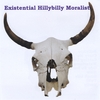Classical description in a quantum spirit of the prototype four-atom reaction OH + D2
J. Espinosa-Garcia, L. Bonnet and J. C. Corchado
Classical mechanics is the only practical way to simulate internuclear motion in many complex systems that are important for biology, materials science, and technology. It is therefore important to test classical dynamics on simpler systems. The OH + H2 or OH + D2 system is the prototype four-body chemical reaction for fundamental studies of this nature, and high-resolution experiments have been reported by Davis and co-workers. Here we use those experiments to test state-resolved quasi-classical trajectory calculations in a quantum spirit, and find good agreement with experiment. Our simulations correctly predict that the newly formed oxygen–deuterium bond in the HOD product is preferentially excited to the vibrational state v = 2, and they yield a state-resolved product translational energy distribution. Of especial interest is that the triple (angle-velocity) differential cross section shows the same state-resolved structure associated with the product vibrational states that were analyzed. This level of accuracy has previously been achieved only for triatomic systems, and these new simulations demonstrate that the quasi-classical method with quantum corrections may represent a reasonable alternative to quantum scattering approaches for the description of polyatomic reaction dynamics.


No comments:
Post a Comment